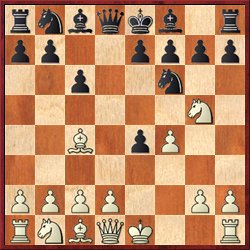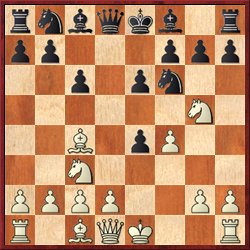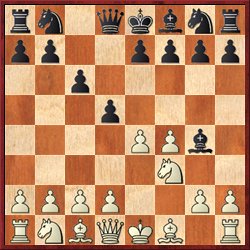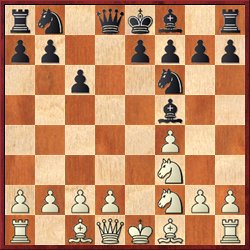As anybody who has seen my ChessLectures or read enough of this blog knows, one of my favorite opening experiments of all time was the following queen sacrifice against the Sicilian Defense: 1. e4 c5 2. f4 d5 3. Nf3!? de 4. Ng5 (a Budapest Defense reversed) .Nf6 5. Bc4 Bg4?! (probably a mistake) 6. Qxg4!?!. In 2006 I beat IM David Pruess with this line as White, and then lectured about the game in my first-ever ChessLecture, which was called “Nuke the Sicilian!”
The real problem with this “Nuke the Sicilian Variation” (actually called the Bryntse Gambit) is that Black does not have to chase the queen recklessly with 5. … Bg4. He can instead play more circumspectly with 5. … e6. White recovers his sacrificed pawn, but the position is pretty much equal.
It’s hard to believe, but the question never popped into my head until last night: “Why not nuke the Caro?” That is, what happens if White plays the same sequence of moves against the Caro-Kann?
1. e4 c6 2. f4 d5 3. Nf3 de 4. Ng5 Nf6 5. Bc4 … (diagram)
Here we have exactly the same position as in the Bryntse Gambit, only with Black’s pawn on c6 instead of c5. What difference do you think that alteration makes? Does it make the variation better or worse for White?
I’ll let you think about that a little bit, while I say a little bit about the history. When I looked this position on ChessBase up, it was interesting to see that someone else had already had this idea. Not Arne Bryntse, the Swedish correspondence player who pioneered the Bryntse Gambit — he apparently never thought of playing it against the Caro. However, there is a Polish player named Wladyslaw Krol, rated in the 2200-2300 range, who has played this sequence of moves several times against both the Sicilian Defense and the Caro-Kann. Since the concept occurs in more than one opening, perhaps instead of the Bryntse Variation we should call it the Krol Koncept. But for now I’ll keep using two separate names, and call this the Caro-Kann-Krol.
So far I have only analyzed this on my computer; I haven’t even played a blitz game with it. So any conclusions I might draw at this point are very tentative. However, I think that if Black takes the queen sacrifice, White’s attack is even stronger than in the Bryntse Gambit. That is, if we play the moves:
5. … Bg4 6. Qxg4! Nxg4 7. Bxf7+ Kd7 8. Be6+ … (diagram)
If Black continues 8. … Kc7? here, I think he is just busted. The reason is that after 9. Bxg4 Qe8 10. Ne6+ Kb6 11. d3! with the idea of 12. Be3+, Black is almost certainly going to have to play … c5 at some point. Then we will have a position exactly like the Bryntse Gambit except Black will be a tempo down. In an opening where White’s lead in development is of paramount importance, Black just can’t afford to lose another tempo.
Unfortunately, Black could (in fact, has to) play 8. … Ke8 instead, inviting a draw by repetition after 9. Bf7+. In the Bryntse, I don’t think White has to settle for a draw; I still think he has reasonable chances for an advantage after 9. Bxg4. However, this position is different. Black has possibilities of … Na6-c5 (either defending the e4 pawn or exchanging off some material if White has already taken on e4) and he also has possibilities of … Qb6, which makes it hard for White to castle. In the Bryntse those possibilities don’t exist because the pawn is on c5.
However, I think the real problem with the Caro-Kann-Krol is that Black’s “declining” move, 5. … e6, is even stronger. The computer and I both think that White’s best response is 6. Nc3.
Now, unlike in the position with the pawn on c5, Black has a plan of expanding on the queenside with 6. … b5. After 7. Bb3 the computer says that best play is 7. … Nbd7 8. Ngxe4 b4 9. Nxf6+ Qxf6. NowWhite has a choice of an unclear gambit with 10. Ne4 Qxf4 or passive defense with 10. Ne2. In either case, Rybka 3 thinks that Black has about a ½-pawn advantage. Further tests are obviously needed.
Interestingly, in the games in ChessBase hardly anyone tried … b5 for Black. If White is given time to play a4, then I think I’m pretty happy to play this position.
There’s one more issue that may make the Caro-Kann-Krol less appealing. After 3. Nf3 Black does not have to accept White’s gambit, but can instead play 3. … Bg4. I think that this move just about equalizes on the spot.
I’m not the only one who thinks so; Rybka 3 does, too. If 4. e5 it looks as if we’ll have a very reasonable version of the Advance Variation. Rybka prefers 4. Nc3, which could lead to the following amusing position after4. … de 5. Nxe4 Nf6 6. Nf2 Bf5.
Kinda crowded on that f-file!
I think that I probably will give the Caro-Kann-Krol a try at least once or twice, partly because I am looking for new things to play against the Caro. The “Homo Erectus” variation that I wrote about previously in this blog, 1. e4 c6 2. d4 d5 3. e5 Bf5 4. g4!?, is fun but awfully loose, and I think that IM Mark Ginsburg’s recipe against it, 4. … Be4 5. f3 Bg6 6. h4 h5 7. Ne2 hg 8. Nf4 Bh7! is probably good for Black. It’s too bad to give up on something I have worked so hard on and played so many times, but against masters I need something more reliable.








{ 5 comments… read them below or add one }
Thanks a lot McKenzie! I just started to play CK as Black and now I have another thing to worry about. Great 🙂
What about after 1. e4 c6 2. f4 e5 same thing could happen In the Sicilian how should white respond to that? Clearly someone who wants to play either of these gambits must know how to face this.
Fantastic article! I love this sideline and am rushing off to try it right now. This is the first time I’ve come across your blog and I’m thrilled to discover it… good stuff.
Have you ever considered using simmiler lines deriving from the Scandinavian Defense? think about it’s the same deal except neither side has moved the extra pawns.
1.e4 d5
2.Nf3 dxe
3.Ng5 Nf6
Bc4
I hope I did not miss a hint in your remarks but do you know Hergert’s article about this Caro-Kann nuke in Kaissiber No.37 (2010)?
{ 2 trackbacks }